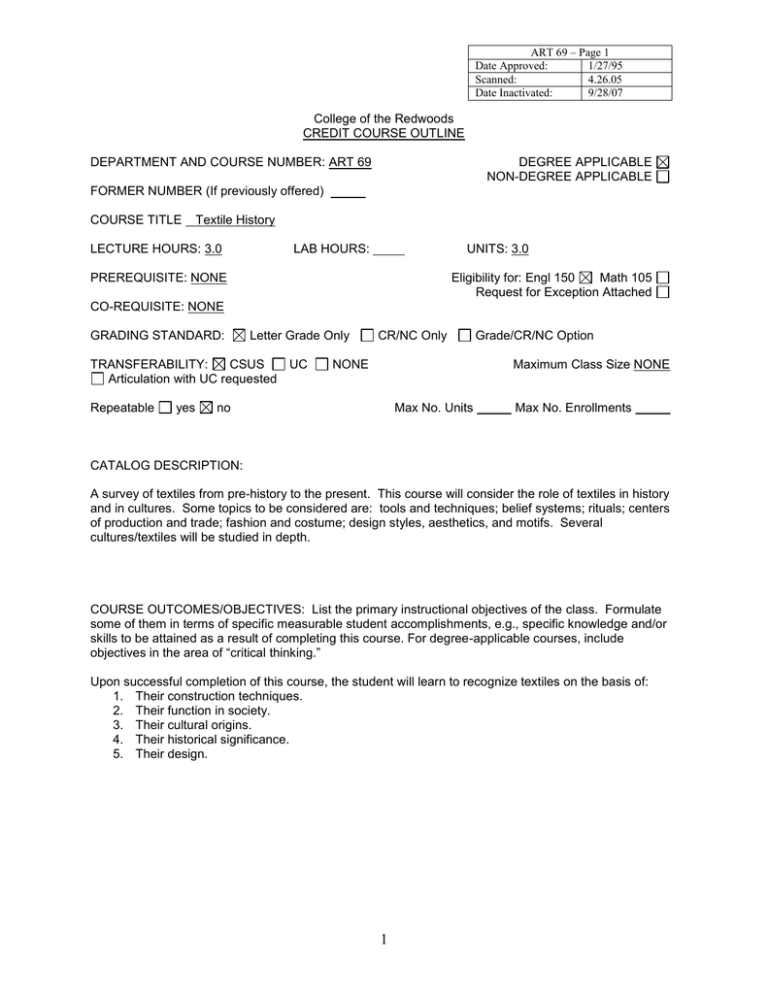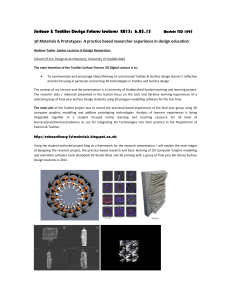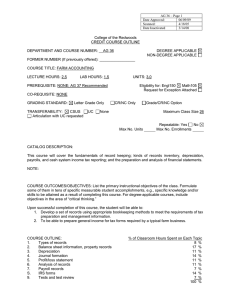College of the Redwoods CREDIT COURSE OUTLINE
advertisement

ART 69 – Page 1 Date Approved: 1/27/95 Scanned: 4.26.05 Date Inactivated: 9/28/07 College of the Redwoods CREDIT COURSE OUTLINE DEPARTMENT AND COURSE NUMBER: ART 69 DEGREE APPLICABLE NON-DEGREE APPLICABLE FORMER NUMBER (If previously offered) COURSE TITLE Textile History LECTURE HOURS: 3.0 LAB HOURS: UNITS: 3.0 PREREQUISITE: NONE Eligibility for: Engl 150 Math 105 Request for Exception Attached CO-REQUISITE: NONE GRADING STANDARD: Letter Grade Only TRANSFERABILITY: CSUS UC Articulation with UC requested Repeatable yes CR/NC Only NONE Grade/CR/NC Option Maximum Class Size NONE no Max No. Units Max No. Enrollments CATALOG DESCRIPTION: A survey of textiles from pre-history to the present. This course will consider the role of textiles in history and in cultures. Some topics to be considered are: tools and techniques; belief systems; rituals; centers of production and trade; fashion and costume; design styles, aesthetics, and motifs. Several cultures/textiles will be studied in depth. COURSE OUTCOMES/OBJECTIVES: List the primary instructional objectives of the class. Formulate some of them in terms of specific measurable student accomplishments, e.g., specific knowledge and/or skills to be attained as a result of completing this course. For degree-applicable courses, include objectives in the area of “critical thinking.” Upon successful completion of this course, the student will learn to recognize textiles on the basis of: 1. Their construction techniques. 2. Their function in society. 3. Their cultural origins. 4. Their historical significance. 5. Their design. 1 ART 69 – Page 2 Date Approved: 1/27/95 Scanned: 4.26.05 Date Inactivated: 9/28/07 COURSE OUTLINE: % of Classroom Hours Spent on Each Topic TOOLS: The development of looms, dyes, and processes 15% TECHNIQUES: Printing, dyeing, weaving, and other textile constructions from These geographic areas 15% CULTURES: History, belief systems, and functions (including tribal art, Sacred art, ritual objects, and status objects) 15% MAJOR PERIODS OR STYLES 25% TRADITION AND CHANGE: Influences on the development of textiles; Trade routes, appropriations, and “borrowing” 10% FASHION AND COSTUME: The Decorated Body; economics, status, Styles, construction, and tailoring 10% DESIGN STYLES AND AESTHETICS: Motifs, signs, and symbols 10% APPROPRIATE TEXTS AND MATERIALS: (Indicate textbooks that may be required or recommended, including alternate texts that may be used.) Text(s) Title: Textiles: 5,000 Years Required Edition: Alternate Author: Jennifer Harris Recommended Publisher: Harry N. Abrams Date Published: 1993 (Additional required, alternate, or recommended texts should be listed on a separate sheet and attached.) For degree applicable courses the adopted texts have been certified to be college-level: Yes. Basis for determination: is used by two or more four-year colleges or universities (certified by the Division Chair, or Branch Coordinator, or Center Dean) OR has been certified by the LAC as being of college level using the Coleman and Dale—Chall Readability Index Scale. No. If no text or a below college level text is used in a degree applicable course, a Request for Exception form must be completed and a rationale provided. This request for exception will be approved or denied by the Curriculum Committee. 2 ART 69 – Page 3 Date Approved: 1/27/95 Scanned: 4.26.05 Date Inactivated: 9/28/07 METHODS TO MEASURE STUDENT ACHIEVEMENT: Please check where appropriate; however, a degree applicable course must have a minimum of one response in category 1, 2, or3. If category 1 is not checked, the department must explain why substantial writing assignments are an inappropriate basis for at least part of the grade. 1. Substantial writing assignments, including: essay exam(s) term or other paper(s) written homework reading report(s) laboratory report(s) other (specify) If the course is degree applicable, substantial writing assignments in this course are inappropriate because: The course is primarily computational in nature. The course primarily involves skill demonstrations or problem solving. Other rationale (explain) 2. Computational or Non-computational problem-solving demonstrations, including: exam(s) quizzes homework problems laboratory report(s) field work other (specify) 3. Skill demonstrations, including: class performance(s) other (specify) 4. Objective examinations, including: multiple choice completion field work performance exam(s) true/false other (specify) matching items 5.Other (specify) _______ NOTE: A course grade may not be based solely on attendance. REQUIRED READING, WRITING, AND OTHER OUTSIDE OF CLASS ASSIGNMENTS: Over an 18-week presentation of the course, 3 hours per week are required for each unit of credit. ALL Degree Applicable Credit classes must treat subject matter with a scope and intensity which require the student to study outside of class. Two hours of independent work done out of class are required for each hour of lecture. Lab and activity classes must also require some outside of class work. Outside of the regular class time the students in this class will be doing the following: Study Answer questions Skill practice Required reading Problem solving Written work (essays/compositions/report/analysis/research) Journal (reaction and evaluation of class, done on a continuing basis throughout the semester) Observation of or participation in an activity related to course content (e.g., play, museum, concert, debate, meeting, etc.) Field trips Other (specify) 3 ART 69 – Page 4 Date Approved: 1/27/95 Scanned: 4.26.05 Date Inactivated: 9/28/07 COLLEGE LEVEL CRITICAL THINKING TASKS/ASSIGNMENTS: Degree applicable courses must include critical thinking tasks/assignments. This section need not be completed for non-degree applicable courses. Describe how the course requires students to independently analyze synthesize, explain, assess, anticipate and/or define problems, formulate and assess solutions, apply principles to new situations, etc. 1. Students will analyze various ways of constructing textiles. 2. Students will evaluate the constructions’ significance in terms of the design and manufacture of the textile. 3. Students will assess the role and significance of textiles within cultures 4. Students will formulate theories about the role and influence of textiles on history. 5. Students will independently research specific techniques, cultures, historical time, or functions of textiles. 6. Students will learn to analyze textiles to place them in terms of culture and construction. 4 ART 69 – Page 5 Date Approved: 1/27/95 Scanned: 4.26.05 Date Inactivated: 9/28/07 REQUEST FOR EXCEPTION The Curriculum Committee is authorized to determine the appropriateness of entrance skills and requisites for any given course; to determine whether or not language and/or computational skills at the associate degree level are essential to success in a given course; to determine what is “college level” in learning skills, vocabulary, and in the ability to think critically and apply concepts; and to determine on a case-by-case basis when any departure from the attached guidelines may be justified. To request an exception, provide the following information: ART 69 Department and Course No. Textile History Course Title Nature of the Exception Requested and Rationale: TEXT No appropriate text exists that covers all topics adequately. Portions of the following books will be used in the place of a single text, and an extensive bibliography will be passed out at the first meeting. A History of Textiles, Kay Wilson, Westview Press, Boulder, Colorado, 1979. Textile Art, Michel Thomas, C. Maiguy, S. Pommier, Skira/Rizzoli, 1985. A History of Textile Art, Agnes Geijer, Pasold Research Fund with Sotheby, Parke, Bernet. Textiles: 5,000 Years, Jennifer Harris, Harry N. Abrams, 1993. 5






